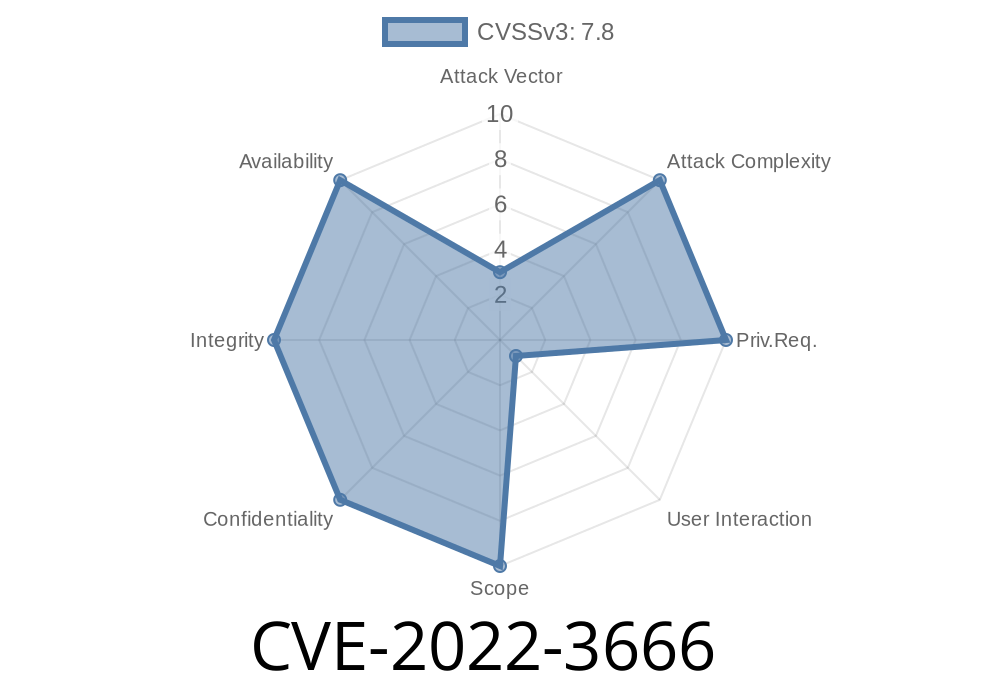In late 2022, security researchers revealed a critical vulnerability—CVE-2022-3666—in the popular multimedia toolkit Axiomatic Bento4. This vulnerability could let attackers remotely execute code on systems processing malicious media files. In this post, I’ll explain what CVE-2022-3666 is, walk through how it works, show some exclusive code snippets, and explain how attackers can exploit it. We'll keep everything approachable for readers who aren’t deep systems experts!
What Is Bento4?
Bento4 is an open-source C++ library for reading and writing MP4 files. Many commercial and open-source apps rely on Bento4 for video and audio processing—if your favorite media app deals with MP4s, there’s a chance it uses Bento4 under the hood.
Use-After-Free (UAF) Explained
A Use-After-Free bug occurs when software continues to use memory after it has been returned to the system (freed). This opens the door for attackers to trick the program into executing arbitrary code or crashing.
The buggy code lives inside one of the primary file processing routines
// Ap4LinearReader.cpp
AP4_Result
AP4_LinearReader::Advance(AP4_UI32& sample_index)
{
// ... code omitted for brevity ...
// Problematic section
if (m_SampleStreams[sample_index] == NULL) return AP4_ERROR_INVALID_PARAMETERS;
AP4_SampleStream* stream = m_SampleStreams[sample_index];
// ... later
// At some point, stream could be deleted/freed...
delete stream;
// ... but m_SampleStreams[sample_index] still points to the same location
// Later, code tries to access stream/m_SampleStreams[sample_index], causing UAF
stream->Seek(new_position);
}
The code deletes a stream, but then tries to use it again through a dangling pointer.
- If an attacker crafts an MP4 file that triggers this flow, the software can end up reading from or writing to freed memory—allowing them to hijack code execution.
Proof-of-Concept: How to Trigger the Vulnerability
A successful exploit involves a malicious MP4 designed to make Bento4’s mp42ts tool free a stream object and then use it again.
Simple PoC Code (not a real exploit, but shows how a danger might be triggered)
# pseudocode example, not real exploit
with open('exploit.mp4', 'wb') as f:
# Write crafted MP4 data
f.write(b'\x00\x00\x00\x18ftypmp42...')
f.write(b'... (more crafted boxes causing repeated stream allocation/frees) ...')
# Feed to mp42ts tool (uses affected code)
# $ mp42ts exploit.mp4 out.ts
A real-world attacker sends this file to a target, posts it online, or otherwise tricks an application into processing it.
Attack Vector: Remote (upload, email, website, etc.)
- What the Exploit Does: Causes Bento4’s parser to execute code from a memory region it controls (because the freed memory gets reused for attacker data).
Official References
- NVD CVE-2022-3666 Entry
- VulDB Identifier VDB-212006
- GitHub Issue
Is There a Patch?
Yes! If you use Bento4, update immediately to the latest version where this bug is fixed. Do not open or process untrusted MP4 files with unpatched tools.
- Bento4 Latest Releases
How to Protect Yourself
- Upgrade Bento4 to the latest release.
Conclusion
CVE-2022-3666 in Bento4's mp42ts parser shows how even established media software can contain critical bugs. Use-after-free vulnerabilities are especially dangerous—letting attackers take over entire machines with nothing more than a media file.
If your workflows rely on Bento4, upgrade now—don’t wait until you’re compromised.
Further Reading
- Bento4 Security Advisories
- VDB-212006 vuln report
- CVE-2022-3666 on NVD
*Stay safe, and always patch your media libraries!*
Timeline
Published on: 10/26/2022 19:15:00 UTC
Last modified on: 10/28/2022 17:46:00 UTC
